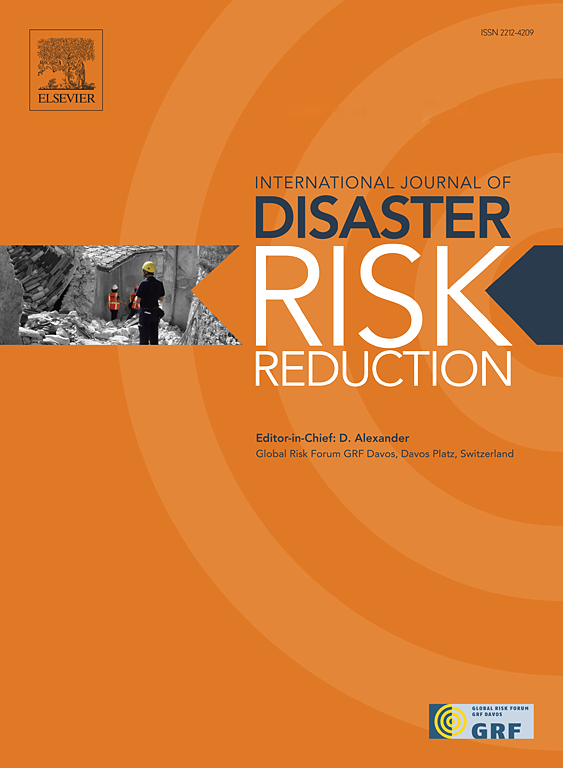假设飓风后居民活动和服务的恢复优先级:来自大都市调查数据的见解
IF 4.5
1区 地球科学
Q1 GEOSCIENCES, MULTIDISCIPLINARY
International journal of disaster risk reduction
Pub Date : 2025-08-05
DOI:10.1016/j.ijdrr.2025.105741
引用次数: 0
摘要
本研究调查了受飓风影响的大都市地区居民恢复电力公用事业和交通基础设施的优先次序。利用分布在美国四个主要城市(休斯顿、纽约、华盛顿特区和迈阿密)的调查,该研究提出了假设的飓风,以探索人口统计学、社会经济特征、工作特征和可替代能源的获取如何影响个人对恢复中断的活动和服务的偏好。通过应用秩序logit模型,包括潜在类和递归划分技术,研究确定了不同群体的不同偏好模式。潜类秩序logit模型揭示了三个不同的恢复优先级组。例如,有灵活工作选择和可获得替代能源的年轻居民优先考虑为其社区提供就业和银行服务,而家中没有子女的年长工作年龄居民则重点关注食品和保健服务。这些见解强调了在恢复和恢复计划中认识到这种异质性的重要性。另一方面,递归划分方法有效地捕捉了广泛的趋势,例如卫生和食品等基本服务的优先次序,但在揭示更详细的偏好差异方面存在局限性。该研究提倡对灾害恢复和恢复采取更有针对性的方法,不仅要优先考虑技术和基础设施的恢复,而且要与受灾人口的具体需求和偏好保持一致。通过使恢复工作更紧密地与居民的偏好相结合,政策制定者和应急管理人员可以提高灾后恢复工作的效率和观感,最终使城市社区更具复原力。本文章由计算机程序翻译,如有差异,请以英文原文为准。
Resident recovery priorities for activities and services after a hypothetical hurricane: Insights from metropolitan survey data
This study investigates the recovery priorities of residents in metropolitan areas for restoring electric power utility and transportation infrastructure impacted by hurricanes. Utilizing a survey distributed across four major U.S. cities—Houston, New York City, Washington D.C., and Miami—the research poses hypothetical hurricanes to explore how demographics, socio-economic features, work characteristics, and access to alternative power source(s) influence individual preferences for restoration to recover disrupted activities and services. Through the application of rank-ordered logit models, including latent class and recursive partitioning techniques, the study identifies distinct preference patterns across various groups. The latent class rank-ordered logit model reveals three distinct groups with varied recovery priorities. For instance, younger residents with flexible work options and access to alternative power sources prioritize employment and banking services for their community, while older working-age residents without children at home focus on food and health services. These insights highlight the importance of recognizing such heterogeneity in restoration and recovery planning. On the other hand, the recursive partitioning approach effectively captures broad trends, such as prioritization of essential services like health and food, but shows limitations in revealing more detailed preference differences. The study advocates for a more tailored approach to disaster restoration and recovery that not only prioritizes technical and infrastructural restoration but also aligns with the specific needs and preferences of the affected populations. By aligning recovery efforts more closely with resident preferences, policymakers and emergency managers can enhance the efficacy and perception of post-disaster recovery efforts, ultimately leading to more resilient urban communities.
求助全文
通过发布文献求助,成功后即可免费获取论文全文。
去求助
来源期刊

International journal of disaster risk reduction
GEOSCIENCES, MULTIDISCIPLINARYMETEOROLOGY-METEOROLOGY & ATMOSPHERIC SCIENCES
CiteScore
8.70
自引率
18.00%
发文量
688
审稿时长
79 days
期刊介绍:
The International Journal of Disaster Risk Reduction (IJDRR) is the journal for researchers, policymakers and practitioners across diverse disciplines: earth sciences and their implications; environmental sciences; engineering; urban studies; geography; and the social sciences. IJDRR publishes fundamental and applied research, critical reviews, policy papers and case studies with a particular focus on multi-disciplinary research that aims to reduce the impact of natural, technological, social and intentional disasters. IJDRR stimulates exchange of ideas and knowledge transfer on disaster research, mitigation, adaptation, prevention and risk reduction at all geographical scales: local, national and international.
Key topics:-
-multifaceted disaster and cascading disasters
-the development of disaster risk reduction strategies and techniques
-discussion and development of effective warning and educational systems for risk management at all levels
-disasters associated with climate change
-vulnerability analysis and vulnerability trends
-emerging risks
-resilience against disasters.
The journal particularly encourages papers that approach risk from a multi-disciplinary perspective.
 求助内容:
求助内容: 应助结果提醒方式:
应助结果提醒方式:


